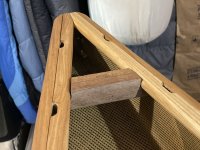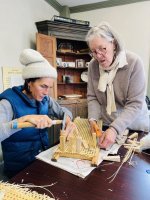Looks nice—it’s exciting to see this coming along, and I look forward to seeing the final results and hearing your impressions after your test paddle and your trip!
As for your question about kneeling: I alternate between the two positions you describe. I think I find myself with my feet flat/toes pointed toward the stern most of the time, but I definitely got a little sore from doing that until I bought a kneeling pad that I could fit my feet onto so that my ankles would be cushioned, rather than pressed against the hard bottom of the canoe (some kind of dedicated ankle cushion—e.g. a pool noodle?—would probably give the same benefit). When I want to put the balls of my feet on the floor, the seat can get in the way if I’m wearing water shoes; I solve that by taking my shoes off while I’m paddling (but NB: being shoeless could be a safety issue in a capsize—neoprene boots/shoes/socks like @Glenn MacGrady mentioned are a better idea!).
You’re definitely right that adding a load will help alleviate any twitchiness you might feel. Also, “twitchy” is the most descriptive word I can think of, but it makes me picture a canoe that feels eager to dump you, and so I want to clarify that that’s not the Yellowstone Solo: even empty, it feels incredibly secure, but it always wants to roll around underneath you rather than settle into one position like a flatter-bottomed canoe does. Loading it up with a few days’ worth of camping gear diminishes that feeling and lets you relax while sitting, even with the seat set up for kneeling.
I use that same Northstar pad. Seemed awfully expensive but I wouldn’t be without it. And I do use a pool noodle under my ankles. Can’t kneel very long without it. Sometimes straightening up off the seat is enough to get a break, but sometimes I need to sit and stretch my legs.























